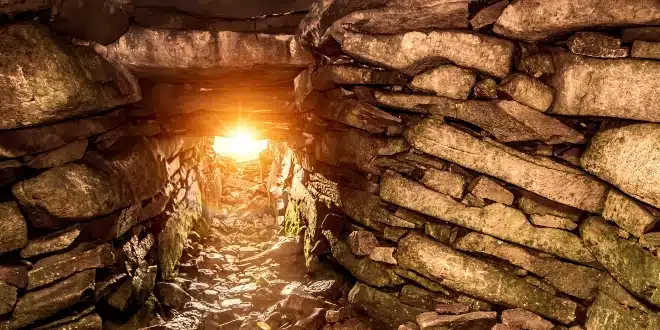Over 2,000 people gathered this morning at Newgrange in County Meath to witness the Winter Solstice, marking the shortest day and longest night of the year. Although the sun broke through the clouds, it was too late to fully light the central chamber of the Neolithic tomb. However, this did not dampen the spirits of the largest crowd at the site in over a decade, with attendance boosted by the fact that the 21st of December fell on a Saturday.
Cloud cover obscured most of the 17-minute window when sunlight can illuminate the chamber, but as the time drew to a close, a brief moment of sunlight lit up the space. This provided a hopeful conclusion for those gathered both inside and outside the monument. While 18,500 people entered a lottery for a chance to experience the solstice firsthand, only 16 ticket holders were granted access to the tomb’s central chamber. These lucky individuals came from across Ireland and the US.
Meanwhile, viewers from around the world tuned into a live stream of the event. The Office of Public Works reported that over 28,000 people from countries as distant as New Zealand watched the sunrise via YouTube. Jon Krolewicz and Meagan Nowack from South Carolina, who visited Newgrange the previous year, returned to Ireland for the solstice. Despite the weather, they felt privileged to be inside the chamber during the event, capturing a glimpse of sunlight. Nowack shared how the experience of standing in the ancient chamber, reflecting on its history and the people who had visited before them, made the event feel intensely personal.
The Winter Solstice occurs when the sun reaches its southernmost point, directly over the Tropic of Capricorn, around December 21st. The sun remains in this position for three days before it begins to move north again. For about 17 minutes, sunlight can shine through a small opening above Newgrange’s entrance, known as the ‘roof box,’ and illuminate the tomb’s central chamber.
Newgrange, along with the nearby tombs of Dowth and Knowth, is part of the Brú na Bóinne UNESCO World Heritage Site, located about eight kilometers west of Drogheda. These Neolithic structures, built around 3200 BC, are considered among the most significant prehistoric sites in the world and house the largest collection of megalithic art in Western Europe.
 The Daily Star Ireland
The Daily Star Ireland
